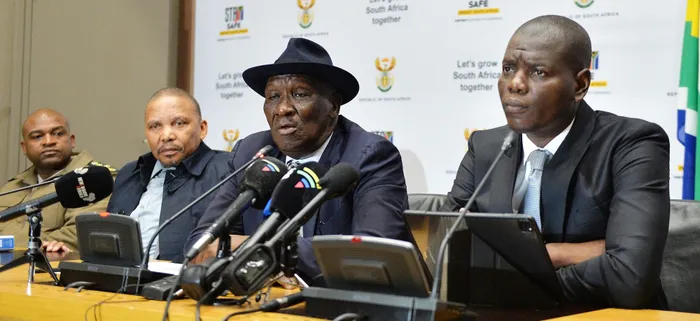Corruption in prisons threatens the criminal justice system

Picture: Phando Jikelo / African News Agency (ANA) – Justice and Correctional Services Minister Ronald Lamola, right, and Police Minster Bheki Cele, second right, at Portfolio Committee on Justice meetings on the circumstances surrounding the escape of Thabo Bester from the Mangaung Correctional Centre.
By Selby Makgotho
The jaw-dropping parliamentary inquiry into the escape of rapist and murderer Thabo Bester from the Mangaung Correctional Centre in Bloemfontein has given rise to the need for closer scrutiny of corruption at prisons in the country.
South Africans could not believe Bester had staged a movie-like act that went on for almost a year, without anyone in authority noticing he was freely roaming the streets of Johannesburg with the help of his lover, Dr Nandipha Magudumana.
Victims of Bester’s criminal deeds would have felt more at risk upon hearing of the escape. Adding insult to injury are reports that Bester and his girlfriend lived a lavish lifestyle in the suburbs of Johannesburg, undetected. Who else knows what they did to the victims or any other person whose presence threatened them between the time he escaped from prison and the time it was known that he had escaped?
A study on “Tackling Correctional Corruption”, by the Centre for the Advancement of Public Integrity, lists the running of criminal enterprises within prisons and drug related criminality as the two key areas where there are huge problems of corruption.
The centre says the prisoners work in cahoots with prison officials who serve as conduits and proxies of the prisoners involved in criminal activities. The study’s findings list some of the corruption methods, such as interactions between individual prisoners and prison personnel, interactions between the administration of an individual prison and prisoners, interaction with external individuals and groups, the prison administration where procurement and supplies are involved and prison officials where decisions, for example, to release a prisoner on parole, can be corruptly made.
It is apparent that Bester employed one or more of the methods to achieve his objectives. He did not work with Magudumana alone. Several prison officials were involved. The controversial and often overlooked corruption crisis in prisons poses a serious threat to the criminal justice system in the country.
It puts the victims at risk and undermines the government’s efforts to arrest perpetrators. In September 1996, the portfolio committee on correctional services argued that corruption was rife in prisons and could no longer be ignored. It was hoped that, through the establishment of the Jali Commission of Inquiry into Prison Corruption, the government would no longer ignore the continued allegations that something was fundamentally wrong in the prisons.
The Jali Commission looked into the various dimensions of corruption, including bribery, embezzlement, fraud, extortion, abuse of power, insider trading and the abuse of privileged information. The commission further raised the three problematic relationships in the prison system set-up: between warders and prisoners; between warders as employees and the Department of Correctional Services as the employer; as well as between external agents, officials and the department.
The supply of drugs by warders to prisoners, gangs operating in prisons, illegal transactions with prisoners and unlawful pecuniary dealings with prisoners were some of the findings made by the Jali Commission in the report handed to the government in 2001.
In the wake of the Bester escape saga, the overall impression gained is that many of the problems identified in the Jali Commission more than 20 years ago remain. The Department of Correctional Services is beset by the same problems as those the commission was established to assist in resolving, with corruption taking centre stage.
According to the department’s 2021/2022 annual report, 22 prison escapes were recorded in the year, 117 inmates escaped the previous year, with about 34 inmates breaking out of correctional facilities in the 2022/2023 financial year.
Bester’s story, coupled with the suspensions and arrests of departmental officials, as well as the modus operandi, gives rise to the suspicion that if one has money to bribe the officials, it is the path to escape. The officials working at prisons need to understand that they play an important role in society and also to the victims of crime. Their loyalty should be to the victims and not the criminals.
However, money seems to be the source of all evil. Prisons, by their nature, are one of the key justice sector institutions characterised by a specific vulnerability to acts of corruption due to the close nature of imprisonment and the inherent risks of insufficient public scrutiny.
Detentions and imprisonment not only mean a severe limitation of the freedom of movement but also a situation in which inmates depend on prison authorities for almost all their daily needs. The UN Office on Drugs and Crime identifies these inherent risks as requiring a heightened degree of state diligence in order to prevent corruption.
The risks are even higher if organised crime groups or other high-risk prisoners manage to come into a position of power through money and control vis-a-vis prison officials as Bester did.
Makgotho is a legal researcher and commentator and a PhD candidate in public constitutional and international law.